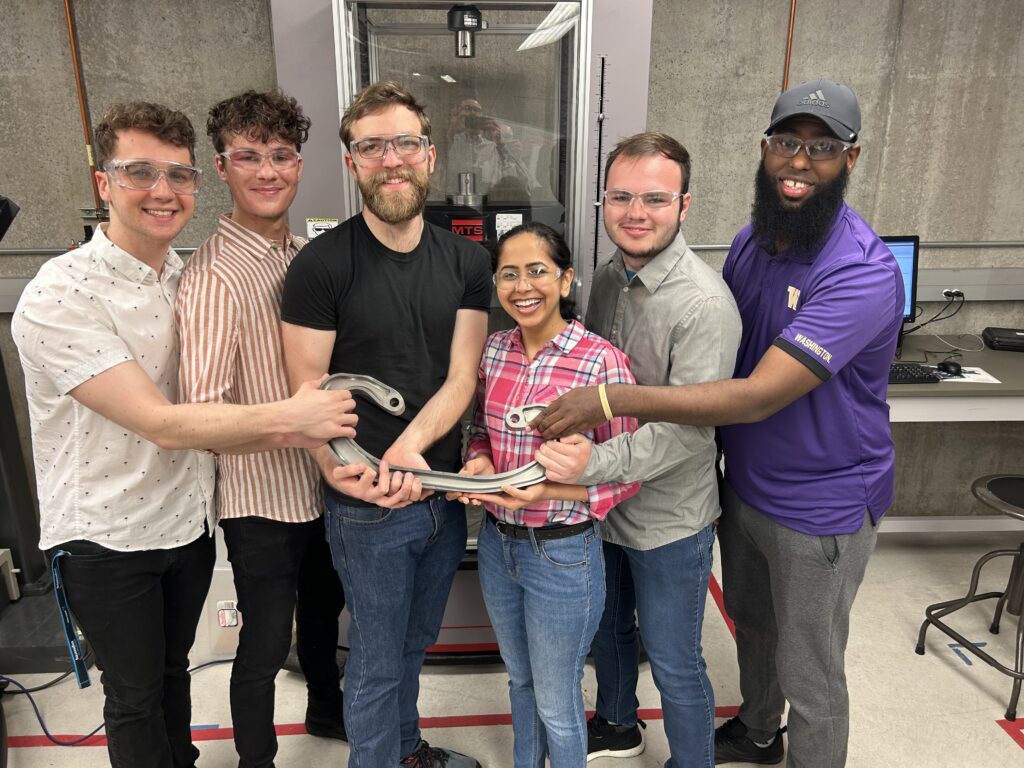Boeing partners with School of STEM to create capstone project
The School of STEM at the University of Washington Bothell has shared several successful collaborations with industry through its engineering capstone program. This year was special however, as for the first time, the School of STEM was honored to have Boeing as one of our industry partners. This year Boeing engineers collaborated with students from the Division of Engineering & Mathematics Mechanical Engineering program (ME).

Six senior mechanical engineering students created their own goose neck hinge, which allows the passenger door of an aircraft to open to 180 degrees. Boeing tasked the students to create a hinge using a more contemporary manufacturing process and more modern materials than the ones they currently use. The team was advised and mentored by Boeing senior technical lead engineers Matthew Soja and Mitchell Mellor, Engineering Capstone Coordinator Dr. Imen Elloumi-Hannachi, ME faculty Dr. John Bridge and Captain Bill Anderson. who continuously collaborated to provide guidance and support to the students throughout the project.
The students, Kacper Syzmanski, Andrey Fomin, William Fogle, Loyan Dude, Simran Deol and Daniel Comsea, who all graduated in June, were selected based on their interests, career aspirations and qualifications for the project. The team split into sub-groups to work on various aspects of the project, from research, manufacturing, design, testing and coding. Led by Syzmanski and Fomin, the team created various designs before finding one that is capable of withstanding 9,000 lbs. of tension and 4,500 lbs. of compression.
“Will, Andrey and I designed our clevis, which is the device that would hold our hinge in testing to verify that it would pass all the loading criteria,” said Syzmanski. “At the same time Loyan, Daniel, and Simran were researching materials to select for our hinge to get an idea of what the material and manufacturing costs would be, and what we could manufacture in house and what would have to be done through vendors.”
Before the project completion, the students were given the opportunity to tour of the Boeing Everett plant and to meet several other Boeing engineers and other students from the Seattle campus working on other capstone projects.
“It was a really great experience working with our Boeing mentors,” said Fogle. “I felt like I learned something new every meeting, whether it was about testing, structural design, or finite element analysis. They also respected our ability to solve problems and would subtly point us in the right direction without giving anything away. Their industry knowledge and experience were invaluable, being able to learn from them was a real privilege.”
Fomin said the experience was an incredible opportunity.
“We were all very excited to see our hinge in person and to test our hinge design. Our hinge met all the criteria given.”
Elloumi-Hannachi, said that the project gave students an opportunity to practice several aspects of engineering they learned in different courses, including design thinking and human centered design, and to develop their engineering skills even further. It also gave them the opportunity to learn more about Boeing culture and needs. The scope of the project was well-defined, and the constraints and requirements were explained to the students well in advance, while the students had to come up with their own design and demonstrate how it works. The students also had to present their work not only at the School of STEM Capstone Symposium, but also at the Boeing campus in front of Boeing engineers and senior leaders, as well as faculty and deans from all three UW campuses.
Bridge said that after this years’ experience, Boeing was interested in doing more projects with UW Bothell students in the future.
“They seemed very happy with the results of our team. This is a perfect capstone/company relationship as the projects envisioned — including the one we just did — are a wonderful mechanical engineering experience for our students,” said Bridge. “They can get their hands around these projects while also helping Boeing. This experience also gives insight to our students into engineering at Boeing and networking opportunities for employment.”
Elloumi-Hannachi says that she was happy that the Boeing engineers took the time to share current job openings at Boeing, and that they were happy to recommend her students for those job openings.
“I am very pleased to see that several of the students already have jobs at Boeing,” she said. “I am excited to continue this partnership with Boeing, we already started discussing the scope of the projects for the next academic year.”